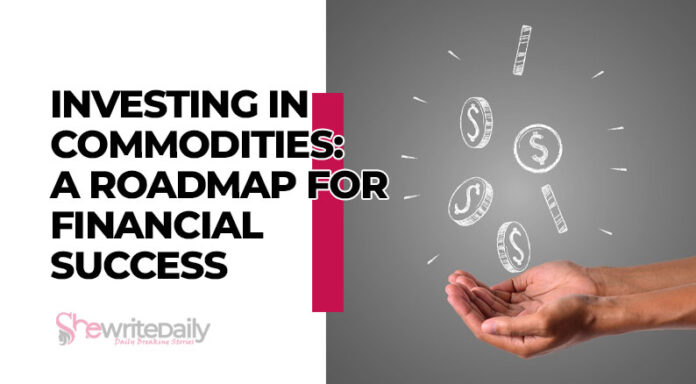Many individuals are familiar with foreign exchange (Forex) and ways to profit from fluctuations in exchange rates and cryptocurrencies. On the other hand, large players frequently make investments in commodities. These can be energy carriers, valuable metals, agricultural products, etc. Each distinct category of the tradable commodity has a unique set of defining traits and a distinct set of driving factors that drive price movement. When these elements are considered, it is possible to forecast how the asset’s value will shift over time.
For investors who have experience, trading in commodities can result in profitable profits. You can directly trade raw commodities, purchase and sell futures contracts, or enter CFD trades. Although the benefits and drawbacks of each approach are easy to grasp, they do exist.
What do we mean when we talk about a commodity?
Commodities take on a distinct physical shape, unlike most financial instruments. In other words, you are permitted to touch them. However, oil is simply a barrel, and a pound of gold is a real nugget of the given mass. This contrasts with bonds and stocks, which provide the owner certain rights (for example, to repay the loan and the part in the company).
Commodities are traded on most of the world’s exchanges and can be purchased through various venues. Curiously, the first stock markets in medieval Europe naturally dealt solely with commodities, most notably spices. Then, the two primary features of assets of this sort, namely their standard nature and fungibility, were recognized.
Because of the particulars of forex trading dealings, raw materials are required to be non-perishable and possess the quality of transportability and the potential for batching (lots). These aspects of commodities are still important today. Additionally, it is now conceivable to trade perishable items, made possible by contemporary storage technologies and efficient logistical practices.
Hundreds of different assets are exchanged on the commodity markets; jointly, these markets are responsible for at least 20% of all international trade. On the other hand, the supply and demand of an item on a worldwide scale are what ultimately decide its price. As a result, conditions are crafted for them on the exchange designed to be as similar as possible to the optimum form of competition. Additionally, the price changes of these assets are sufficiently unpredictable to enable financial gain from even the shortest of time horizons.
Making a profit in the commodities market
A broker is used to transact business in commodities. Commodity futures and Contracts for Difference (CFDs) are the two main forex trading instruments made available by brokers. However, some raw commodities can be traded between individuals without needing a middleman. Think about the benefits and drawbacks of every choice.
Trading of primary resources directly
A person can purchase a platinum, gold, or silver bar. The process is a straightforward and standard operating procedure, often handled by a bank or government-approved institution. Even with this, some things can never be done, such as one individual purchasing oil. Because the government regulates the handling and stockpiling this raw material, only the largest oil-producing and oil-refining corporations must comply with these standards. Grain is extremely difficult to work with; you can go out and get some, but where would you put it? To get a fair return on investment when selling a commodity in the future, it must keep its original features.
Therefore, it is typically very challenging for individual traders to trade commodities directly. Furthermore, there are no advantages to buying precious metals in the form of physical bars as opposed to using CFD contracts or commodities futures.
Prediction markets for agricultural and industrial commodities
In a futures contract, the seller agrees to provide the buyer with a product by a certain date at a certain price, and the buyer agrees to purchase the goods at the agreed-upon price and terms. Futures are a way to lock in a price, shielding you from swings in the currency exchange rate. The baker agrees to buy 100 kilograms of wheat from the farmer at the going rate and then sell it to him a year later. The farmer will sell the wheat at the precise price agreed upon in the contract, regardless of what happens to the exchange rate of wheat in a year.
Additionally, futures are provided at no additional cost. A trader’s so-called collateral (10-40% of the contract value) is blocked on his account, and he pays a commission when a contract is finalized. Collateral on the account will be released after the position is closed. If the futures price is $100, but you only have $20 in your account on average, you’re still ahead of the game. However, you should be aware that the value of the margin might fluctuate, and if you suddenly don’t have the necessary amount in your account, the broker will stop the deal abruptly.
Commodity trading offers numerous benefits, including minimal costs, built-in leverage due to collateral, no limits on short selling, and the ability to hedge. The biggest drawback is that, unlike with stocks, you can’t simply ride out the rough patch and hope that things turn around. Futures offer the opportunity to profit from the asset’s volatility and retain it until maturity.
Contingent Futures Agreements
At its core, a contract for (price) differences (CFD) requires a seller to compensate a buyer for any price disparity between when the contract is signed and when the asset is transferred from one party to the other. The fundamental point is that the buyer has no right to require the seller to provide the goods (here, the raw materials), and the seller has no obligation to provide them. In other words, they are exchanging the same price differential between two dates.
If one uses that definition as a starting point, CFD trading in commodities becomes the most straightforward method available to investors. Any price increase during the contract duration is considered profit for the trader. The dealer must make up the difference to the vendor if the price has dropped. You should know that CFD contracts often don’t have an end date and can be canceled by either party.
Any investor with access to the internet and a licensed broker can trade CFDs. Opening an account and making the first deposit for this trading is subject to minimum s. On the other hand, there is a substantial downside in the form of a loss of capital should the price move in the wrong direction. This is a form of trading known as margin, which can enhance both gains and losses.


